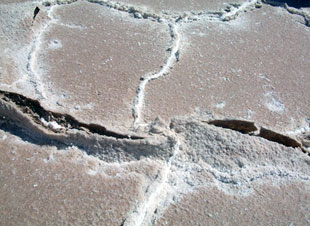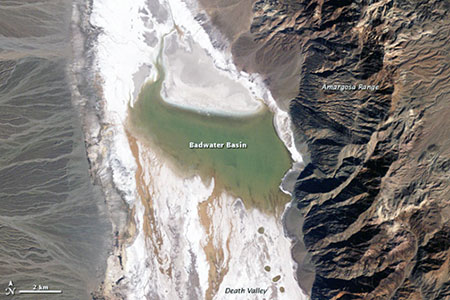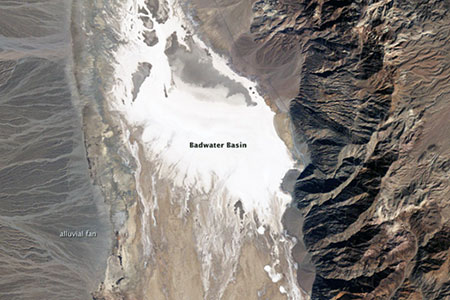Geology and Natural Heritage of the Long Valley Caldera
The Formation of Badwater Basin and the Death Valley Salt Flats
Grace Minton–Morgan
Abstract
The iconic landscape of Badwater Basin, located in Death Valley National Park, rests 282 ft (86 m) below sea level; the lowest point in North America. It is home to a varied collection of landforms and features – many of them ephemeral – including salt flats, saline springs, ephemeral lakes, and their resultant muddy deposits. The unique landscape is a result of ancient volcanism, climate, and flooding combined with modern weather patterns and underground hydrothermal activity. Of these factors, flooding and hydrothermal activity are perhaps the most dramatic, as they visibly alter the terrain in ways directly observable on timescales of a few years. Similarly, two most notable features of Badwater Basin – its sprawling salt flats and its namesake Badwater Spring – are inextricably linked together in that the minute spring–fed lake provides the hydrological activity necessary to give the salt flats their unique geometric character as distinct from other salt deposits around the Valley.
INTRODUCTION
What mysteries lay at the lowest point in North America? Death Valley is a site unique among the basins in the Basin and Range region; not only is it home to the lowest, hottest point in North America, it also rests in the rain shadow of the 11049 ft. Telescope Peak, giving it a dry, desert climate found nowhere else in the region.
Badwater Basin, the lowest point in Death Valley is a forbidding landscape to human beings, yet is simultaneously home to some of the most fascinating geological and hydrological features in the Northern Hemisphere. The Badwater spring, especially, creates a rare hydrologic desert environment, and in turn, the unique combination of water, dry salt playas, and mountainous features of Badwater are not to be found in such combinations anywhere else in Death Valley.
GEOLOGICAL HISTORY
The current state of Badwater Basin is results wholly from its distant geological past. Closely linked combinations of tectonics, volcanism, and erosion worked over nearly two billion years to shape Death Valley and the Badwater Basin into what they are today. Visual evidence spanning from 1.8 billion year old ocean sediments to modern salt deposits and hydrological land shaping can be seen together in the immediate kilometre or so around Badwater spring.
Composite Materials
Although the landforms in Death Valley are relatively young, geologically speaking – the most ancient rocks to be found within them are more than 1.8 billion years old. These Precambrian rocks make up much of the Valley’s bedrock – though they have undergone heavy alteration and metamorphosis since they were first deposited. These most ancient rocks are only visible in a few locations, one of which, incidentally, is an area of exposure in the cliffs above Badwater.
The majority of the mountains surrounding Death Valley are made up of limestone that was built up at the slow rate of about one one–thousandth of an inch per year during the Paleozoic era, in what was then a shallow watery environment [Bryan and Tucker–Bryan, 1995]. At this time, the area that would become Death Valley looked very different than it does today. A great shift in landscape would occur during the Mesozoic era, when a tectonic collision activated violent volcanism that would contribute a wealth of volcanic rock to the area and dramatically alter the landforms.
A violent Valley
Death Valley itself did not form until several million years after its foundational material was deposited. About 65 million years ago, the eastern edge of the Farallon tectonic plate collided with the western edge of the North American plate (the collision site was located in what is now the state of Utah) [Wallace et al., 1990]. The collision ultimately resulted in the subduction of the Farallon plate as it moved eastward, below the North American plate. As the Farallon plate was subducted, it simultaneously began to "sink" into the Earth’s mantle causing molten material from below began to well up in its place. This molten material erupted in a series of volcanic events during a time called the Nevadan Orogeny (from the Latin oros, meaning "mountain," and the Greek Genes, meaning "birth" (and the English Nevada, meaning "Nevada")). It is thought that the upwelling of material triggered a period of stretching in the North American plate that continues to this day [Lutgens, 2009]. Estimates hold that the crustal stretching has expanded the North American plate by around 150 miles in the East–West direction. The plate stretching also caused the formation of the distinctive basin and range landscape which composes much of the western United States and Mexico: as the North American plate’s lithosphere stretched, certain sections collapsed downwards, creating basins, or grabens, whereas the remaining materials formed ranges, or horsts.
There are more than 200 mountain ranges in North America’s Basin and Range Province; a landscape which was once famously described by geologist Clarence Dutton as looking like an "army of caterpillars marching toward Mexico" [qtd. in Reynolds and Christensen, 2001]. Death Valley is one of the most striking of these basins; laying well below sea level and bordered on the west by the tall Panamint mountain range and on the east by the Black mountains. In addition to altering the landforms, the Nevadan Orogeny and its volcanic environment played a large part in altering the overall geologic texture of the Badwater Basin area as a whole. High temperatures and pressures metamorphosized existing sedimentary rocks, systems of faults carved and split what had once been relatively homogeneous deposits, and hot hydrothermal fluids associated with the volcanism further altered the sediments while simultaneously creating the region’s famous deposits of gold and other ores.
After millions of years of slow sediment deposits had laid down the foundation materials, and violent periods of volcanism and tectonic shifting had added to and shaped them, the primary landscape of Badwater Basin had been established. Smaller, secondary forces would play the final role in creating Badwater Basin as it exists today.
BADWATER
The namesake of Badwater Basin is a small pool of saline water which rests only a few meters from the cliffs of the Amargosa range. The exact dimensions of the pool vary from year to year depending on weather and the amount of water runoff it receives from the nearby mountains.
Although the pool at Badwater is often cited as the lowest point in North America, that point actually rests a few miles out, within the Salt Flats. The pool is often the cited point, however, due to the fact that it is very close in height, easy to locate, and does not wander due to alterations in height of the salt playa as the actual site does. Although the pool’s water is not potable to humans, it is host to a small selection of invertebrate and plant life.
A Spring-–Fed Pool
Nothing in Badwater Basin would be as it is now without the relatively small, permanent pool (sometimes referred to as "Badwater Lake") of "bad water" that is its namesake. But here we must be careful with our terminology. The pool itself and surrounding area were named "Badwater" by early English–speaking travellers who no doubt were disappointed to find that this rare source of water in the desert was too saline to drink. However, the water that flows into the pool actually comes from a freshwater underground spring, such that if one drank the water directly at the source of the spring, it would be potable. The extremely high salinity of the water in the pool comes from the accumulated salts in the ground and on the surface around it, as will be discussed further in the section titled "SALT FLATS".
Water Systems in Death Valley
Springs reaching down to the water table are not uncommon in Death Valley. Indeed, the valley is virtually sliced into pieces by many enormous dip–slip and strike–slip faults; many of these bring groundwater up from below the earth, forming the smattering of small springs and oases throughout the valley. One of the most apparent of these water–siphoning faults is Furnace Creek Fault Zone (though it is structurally distinct from the greater Death Valley Fault Zone), which runs through the center of death valley and may have an offset as large as 50 miles [Bryan and Tucker–Bryan, 1995]. The Badwater Turtleback fault section is approximately 6.5 km long.
Most of the springs in the valley are fed by a relatively large carbonate rock ground water flow system that extends through parts of Nevada and California, where one of its flow paths terminates below the playas of Death Valley. This same aquifer also, naturally, provides water for many other regions outside of the Valley. It is thought that this vast aquifer is slowly depleting in volume due to the region’s geologically recent shift to desert climate (which has reduced water percolation rate), coupled with the fact that the aquifer’s storage capacity is believed to generally deplete much more rapidly than it recharges [USGS, Furnace Creek: Focus on Water, 2012]. It seems possible that, in this way, the harsh, dry, desert climate is in a way reinforcing itself.
Life in Badwater Basin
Several species of plants and animals are native to the area around Badwater. Included among these are salicornia (pickleweed), several species of aquatic worms and insects, and the Badwater Snail (Assiminea infirma), which is endemic to the Mojave Desert. The Badwater Snail thrives only in environments with annual precipitation ≤ 3 cm, and in temperatures bounded between around -5°C and 55°C, making Badwater Lake one of the only ideal habitats for Assiminea infirma [Encyclopedia of Life, Assiminea infima, accessed 2013].
SALT FLATS
A Dry Playa
Badwater Basin – and indeed the whole of Death Valley – was not always the dry, forbidding landscape it is today. Indeed, between only 10 to 12 thousand years ago, during the Pleistocene ice age, the entirety of the valley was filled with recurring, pluvial, freshwater lakes called, collectively, Lake Manly. During this period, the local climate was sub–tropical to tropical in nature, as contrasted to modern Death Valley’s desert climate. At Lake Manly’s peak, the water reached lengths of nearly 160 kilometres and depths of up to 180+ metres. However, the precise history of Lake Manly’s age, extent, and possible alternating periods of dryness and fullness are poorly understood. Radiocarbon analysis of lake deposit cores taken from Badwater Basin have given ages ranging between 11 and 26 ka [Hooke, referenced in Machette et al., 2001], whereas uranium–series disequilibrium dating of tufa remnants indicate ages for what Machette et al. (2001) refer to as the lake’s "most prominent" features ranging between 128–180 ka [Hooke and Lively, 1979, referenced in Machette et al., 2001]. Meanwhile Anderson and Wells [1996, 1997, respectively] concluded from a series of shallow core samples from south of Badwater that numerous, small, separated, ephemeral lakes had existed in Death Valley between 10–35 ka. Naturally, these disparate results have led to some controversy regarding the nature of Lake Manly’s chronology. But this does not need to be the case. Allowing for the error present between various dating methods, as well as the limited nature of some of the samples (Anderson and Wells’ cores, for instance, only reached 26 m in depth), one can interpret the overarching data to indicate that the lake existed in several stages, each varying in depth, size, and persistence. For our purposes in characterizing the modern state of the Badwater Basin area, this assumption of recurrent lakes of varied character shall suffice.
Visual evidence of Lake Manly’s existence is nearly everywhere in Death Valley. A naked eye glance across the valley floor will reveal relatively flat, even terrain characterized by alternating deposits of white salts and dark brown–to–black clays and silts. These salt deposits (composed of 95% sodium (NaCl)) are some of the most obvious evidence of the large water features that once existed in Death Valley. Badwater Basin was (and continues to be) a terminal, or endorheic basin: it allows no outflow to external bodies of water, essentially retaining all inflowing water it acquires until said water evaporates. Endorheic basins typically result in landlocked salt lakes or salt pans due to the fact that salts and sediments cannot drain away. When water evaporates from such a basin, it leaves behind whatever salts and other minerals were dissolved in the water. Thus, one can infer from the vast salt flats present throughout Death Valley that there was once an endorheic lake present there.
Perhaps the most striking of these dry salt playas is the Salt Flats at Badwater Basin. These flats were indeed once below the waters of Lake Manly (along with the rest of Death Valley), but their existence is more complicated than that.
Salt Honeycombs
The Badwater Salt Flats are distinguished from the other salt deposits in Death Valley by their bright white surface and the unique polygonal shapes that form from the cracks in their surface. These salt deposits range in thickness from 8 to 152 cm [USGS, "Badwater," 2013].
As the alkali crust of the salt flats cracks, the cracks meet to form relatively regular, hexagonal shapes. The cracks meet and intersecting angles of approximately 120°, forming a honeycomb–like structure. This uncanny structure likely results from simple geometric efficiency. The 120° angle minimizes the surface area for a given enclosed volume, rendering the quasi-hexagonal shapes the most energy efficient formation for a given space. This is the same reason that honeycombs constructed by bees will also take on tessellated hexagonal structure.
[Image: Photograph showing quasi-hexagonal breakage in salt crust. Scale of individual cells is approx. ½ meter.]
THE TIE BETWEEN BADWATER AND THE SALT FLATS
Badwater spring’s proximity to the salt flats exerts an influence over the character of both features. As has been discussed above, the spring–fed pool would not be so extremely saline if not for the thick salt deposits surrounding it.
So too does Badwater Lake exude influence over the salt flats. The shallow spring provides a catalyst for flooding that exists nowhere else in the valley. Notable flooding is thought to occur on the order of once every thousand years. Such a flood occurred in 2005, when Badwater Basin received around 6 inches of rain (compared to its average 1.5) [NASA Earth Observatory, 2005].
The flood churned up the salt deposits beneath it, dissolving many of the surface crystals. As the water evaporated, it left behind "fresh," bright white, re–crystalized salts atop a slurry of mud. As the mud and salts dried, new instances of the honeycomb–patterned cracks formed. In this way, quasi–regular flooding "replenishes" the salt flats in Badwater Basin – at least in appearance.
[Image: Badwater Basin after the flood of February 2005, showing large pool of greenish floodwater. From NASA’s Landsat 5.]
[Image: Badwater Basin in February 2007, after floodwaters had evaporated. Visible are bright white sodium evaporates. From NASA’s Landsat 5.]
However, the floodwaters are always brief. Death Valley has a 150–inch (381 cm) per year evaporation rate – the highest in the United States – which could dry up a 12–foot–deep, 30 mile long lake within a year [USGS, "Badwater," 2013]. The comparatively small pool–floods typically evaporate in a matter of weeks or days.
CONCLUSIONS
Badwater Basin’s landforms exist as they do today due to a unique combination of geological history, current hydrology, weather, and climate. Were one of these aspects to deviate from its current state, the result would be either an extreme yet temporary alteration (eg: the flood of 2005), or a complete disruption of the landscape. As unforgiving as the basin may seem, it is, in many ways, a fragile system.
Works Cited
Bryan, Scott T., and Tucker–Bryan, Betty, 1995, The Explorer’s Guide to Death Valley National Park. University Press of Colorado.
Encyclopedia of Life. "Assiminea infima" website Accessed 7 June 2013.
Lutgens, Tarbuck, and Tasa., 2009, Earth Science. 12th ed. Pearson Prentice Hall.
Machette, Michael; Ralph Klinger and Jeffrey Knott, 2001. "Questions about Lake Manly’s Age, Extent, and Source." Quaternary and Late Pliocene Geology of the Death Valley Region: Recent Observations on Tectonics, Stratigraphy, and Lake Cycles: G143–G149.
NASA Earth Observatory. (2005). website Accessed 7 June 2013.
Reynolds, D., and Christensen, J., 2001, Nevada. Portland, Or: Graphic Arts Center Pub.
U.S. Geological Survey. (2004). "Badwater." Death Valley Geology Field Trip Website. Accessed 6 June 2013.
Wallace, Robert E., ed., 1990, The San Andreas fault system, California: U.S. Geological Survey Professional Paper 1515, 283 p. website
[Return to Research Projects] [Return to Sierra Home]


